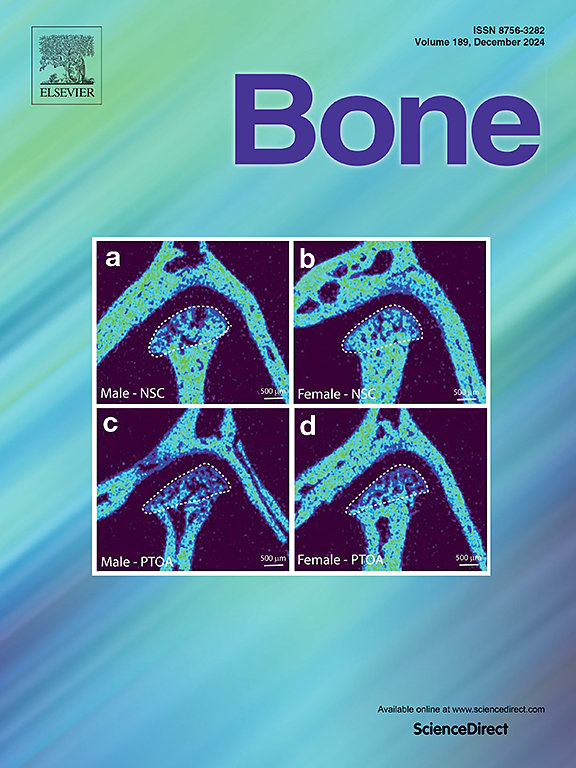基于核磁共振的代谢组学与英国生物银行骨骼健康的关联
IF 3.5
2区 医学
Q2 ENDOCRINOLOGY & METABOLISM
引用次数: 0
摘要
目的:本研究旨在探讨基于核磁共振(NMR)的代谢组学数据与骨折风险和骨密度(BMD)的关系。方法:我们在英国生物银行纳入了69,963名基线时无骨折的参与者。使用Cox比例风险模型来估计核磁共振技术测量的代谢组学生物标志物与所有骨折和髋部骨折风险的关联。我们使用主成分分析(PCA)获得不相关主成分(PC),并进一步使用它们分别估计每个PC与BMD、所有骨折和髋部骨折的关联。结果:在中位随访12.6 年期间,记录了3840例所有骨折和666例髋部骨折。143个代谢组学生物标志物中有94个与所有骨折事件显著相关,81个与髋部骨折事件显著相关。不同脂质成分中的极低密度脂蛋白(VLDL)亚类与多个部位的骨密度增加有关,而高密度脂蛋白(HDL)亚类与骨密度降低有关。较高浓度的小(HR / SD增量:0.92;95 % CI: 0.88-0.97),中(每SD增量HR: 0.91;95 % CI: 0.88-0.94),且较大(每SD增量HR: 0.93;95 % CI: 0.90-0.96)低密度脂蛋白(LDL)颗粒与较低的骨折风险相关。同样,较高的VLDL亚类(不包括非常小的VLDL颗粒)与较低的骨折风险相关。此外,超高和超高高密度脂蛋白的脂质成分(包括总脂质、胆固醇酯、胆固醇和游离胆固醇)水平较高与所有骨折的风险增加有关。PC1(主要由LDL和VLDL的脂质亚类贡献)解释了个体生物标志物的最大差异,与所有骨折的风险呈负相关(P = 7.80E-08)。在髋部骨折中也观察到类似的关联。结论:高水平的大和超大型HDL与骨折风险增加相关,而高脂亚类LDL和VLDL与骨折风险降低相关。不同脂质成分中较高水平的VLDL亚类与多个部位的骨密度增加有关,而较高水平的HDL与骨密度降低有关。本文章由计算机程序翻译,如有差异,请以英文原文为准。
Association of nuclear magnetic resonance-based metabolomics with bone health in the UK Biobank
Objectives
The study aimed to explore associations of metabolomic data based on nuclear magnetic resonance (NMR) with the risk of fractures and bone mineral density (BMD).
Methods
We included 69,963 participants without fractures at baseline in the UK Biobank. Cox proportional hazard models were used to estimate the associations of metabolomic biomarkers measured by NMR technology with the risk of all fractures and hip fracture. We used principal component analysis (PCA) to obtain uncorrelated principal components (PC), which were further used to estimate the associations of each PC with BMD, all fractures, and hip fracture separately.
Results
During a median follow-up of 12.6 years, 3840 incidents of all fractures and 666 incidents of hip fracture were documented. Ninety-four of the 143 metabolomic biomarkers were significantly associated with incident all fractures, and 81 were significantly associated with incident hip fracture. The very low-density lipoprotein (VLDL) subclasses in different lipid constituents were associated with increased BMD at multiple sites, whereas high-density lipoprotein (HDL) subclasses were associated with decreased BMD. Higher concentrations of small (HR per SD increment: 0.92; 95 % CI: 0.88–0.97), medium (HR per SD increment: 0.91; 95 % CI: 0.88–0.94), and large (HR per SD increment: 0.93; 95 % CI: 0.90–0.96) low-density lipoprotein (LDL) particles were associated with a lower risk of all fractures. Similarly, higher VLDL subclasses (excluding very small VLDL particles) were associated with a lower risk of all fractures. Besides, higher levels of lipid constituents (including total lipids, cholesteryl esters, cholesterol, and free cholesterol) of very large and large HDL were associated with an increased risk of all fractures. PC1 (mainly contributed by lipid subclasses of LDL and VLDL), which explained the most variance of individual biomarkers, showed a negative association with the risk of all fractures (P = 7.80E-08). Similar associations were observed for hip fracture.
Conclusions
Higher levels of large and very large HDL were associated with an increased risk of fractures, whereas higher lipid subclasses of LDL and VLDL were associated with a lower risk of fracture. Higher levels of VLDL subclasses in different lipid constituents were associated with increased BMD at multiple sites, while higher level of HDL was associated with decreased BMD.
求助全文
通过发布文献求助,成功后即可免费获取论文全文。
去求助
来源期刊

Bone
医学-内分泌学与代谢
CiteScore
8.90
自引率
4.90%
发文量
264
审稿时长
30 days
期刊介绍:
BONE is an interdisciplinary forum for the rapid publication of original articles and reviews on basic, translational, and clinical aspects of bone and mineral metabolism. The Journal also encourages submissions related to interactions of bone with other organ systems, including cartilage, endocrine, muscle, fat, neural, vascular, gastrointestinal, hematopoietic, and immune systems. Particular attention is placed on the application of experimental studies to clinical practice.
 求助内容:
求助内容: 应助结果提醒方式:
应助结果提醒方式:


